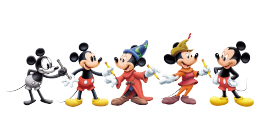It is only in more recent years, with the increased study of the animation art form, that the skill of the background artist has been celebrated. Far more than a simple backdrop for character action, a good background involves the combination of several talents—staging, color styling, and lighting—while maintaining a visual “anonymity” with the viewing audience. Disney has had several superstar background artists: Sam Armstrong, Maurice Noble, Claude Coats, Walt Peregoy, Ralph Hulett, Thelma Witmer, Eyvind Earle, Frank Armitage… and Al Dempster.
Albert Taylor Dempster was born on July 23, 1911, in Atlantic City, New Jersey. He studied for four and a half years at the Art Center School in downtown Los Angeles, shortly after that institution’s founding. Al joined the staff of the Walt Disney Studios on Hyperion Avenue as a layout trainee in March 1939, and within a few months transferred to the Background Department.
It was here, over the next several years, that Al contributed his art to the creation of the Disney animated features Fantasia, Dumbo, Saludos Amigos, Victory Through Air Power, The Three Caballeros, Make Mine Music, and Song of the South.
Al left the Studio in 1945, but by 1952 had returned to work on Peter Pan. He continued to bring his artistry to the features Lady and the Tramp, Sleeping Beauty, One Hundred and One Dalmatians, The Sword in the Stone, The Jungle Book, The Aristocats, Bedknobs and Broomsticks, Robin Hood, and The Rescuers, as well as all the Winnie the Pooh featurettes.
Al left perhaps an even more intimate and enduring legacy in his work on the design and illustration of more than a dozen Disney Golden Books.
Always concerned with controlling the quality of Disney art, Walt would often assign the illustration of books to Studio staff between their other projects. Illustration work by the likes of Disney Legends Mary Blair, Bill Justice, and John Hench is immortalized in many perennially published Disney storybooks.
Walt insisted that some of the studio artists get involved in these book illustrations and he particularly enjoyed seeing the various interpretive approaches that these artists would take, commented Ken Shue, vice president art & design for Disney Publishing Worldwide. In the spirit of every new assignment that Walt gave, he told them to approach storybook illustration in a way that only The Walt Disney Studios would approach it. In other words, given that they were already the world’s greatest storytellers on screen, what would they bring to books that would be innovative, defining, but especially quality in terms of artwork and storytelling?
Al’s illustrations for Santa’s Toy Shop, Walt Disney’s Mother Goose, and Walt Disney’s Uncle Remus Stories are especially fondly remembered, as are his pictures for the Golden Book editions of Three Little Pigs, Snow White and the Seven Dwarfs, Pinocchio, and Alice in Wonderland.
His painting for the cover of the Alice in Wonderland Little Golden Book is considered by many to be the Mona Lisa of Disney storybook illustration, Shue once said. Al loved illustrating books, and that these were done at a time when the studio atmosphere was much like a school, where invention and new ways of tackling any visual storytelling format was exciting and fun. And, boy, it sure shows in the work!
In 1966, at Walt’s personal request, Al donated his time and talent to the creation of the Queen of the World shrine at the St. Elizabeth Hospital in Red Bluff, California. Working from Al’s detailed drawings, Italian sculptor Pasquini Enzo sculpted the central figure of Mary, Mother of God.
Al was the father of five and grandfather of 14. He retired to Los Osos, California in July of 1973, where he passed away on June 28, 2001 at the age of 89.



